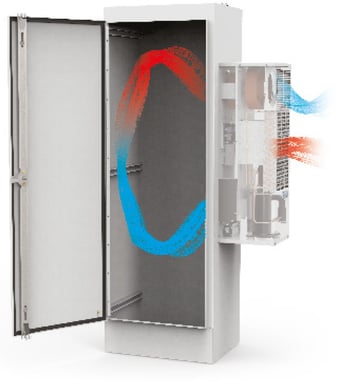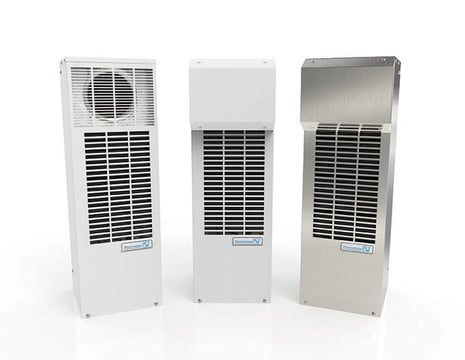How do I know if a cooling unit is the right product for my application?
> If the ambient temperature is greater than the target internal temperature of the enclosure, active cooling is required.
> If a NEMA Type 12 to 4x rating is required - closed loop systems can maintain the NEMA Type rating of the cabinet.
Properly sizing a cooling unit:
To properly size a cooling unit you must know the required cooling capacity in Watts, mounting requirements (side, integrated or top mount) and the dimensions of the unit and enclosure.
{PC = PD - PR } {PR = C x A x ∆T }
> Pc [ Watt ]: > C [ W/m2 °C ]:
Refrigeration capacity of a cooling unit. Coefficient of heat transmission.
> PD [ Watt ]: > A [ M2 ]:
Dissipation Loss: Thermal power Surface area of electronics cabinet.
generated inside a cabinet by the
dissipation loss of components. > ∆T [ °C ]:
Difference in temperature between
> PR [ Watt ]: the ambient air and the air inside the
Radiant heat gain/loss: Heat transfer electronics cabinet.
through the skin of the enclosure
(insulation factor not included).
Utilizing performance curves to properly size cooling units:

Pfannenberg utilizes the DIN standard 35/35 °C when rating our cooling units. Many other companies use 50/50 °C, which provides a higher, non-usable value.
Customers should use their own application temperatures to determine the proper cooling capacity of the system.
To properly size your Cooling Units you can also use Pfannenberg's PSS Software which will guide you through the sizing process, to calculate the correct product for your application.
Important information when utilizing cooling units:
- The refrigeration capacity should exceed the dissipation loss from the installed components by approximately 10%.
- The enclosure should be sealed to prevent the inflow of ambient air.
- Use the door contact switch to impede operation with open doors and consequent excessive accumulation of condensation.
- Use cooling units with maximum clearance between air inflow and air outflow to prevent poor circulation.
- Make sure that the air inflow and air outflow in the external circuit is not hindered, preventing proper heat exchanging at the condenser.
- When using top-mounted cooling units, make sure that components with their own fans do not expel the air directly into the cooling unit‘s cool air outflow.
- Make sure unit is level.
- Setting the temperature to the lowest setting is not the optimal solution due to the condensation issues. The value we have preset on the cooling unit is a sound compromise between cooling the inside of the enclosure and the accumulation of condensation.
Click here to discover our complete range of Cooling Units!








